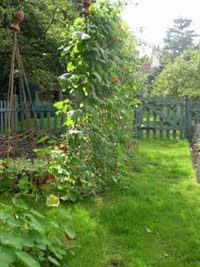Runner Beans
Posted by Fiona Nevile in Vegetables | 4 comments Our runner beans have perked up with all this rain. With their “fresh from the garden” flavour, we could eat them every day. The early beans were poor, even with regular watering but now we are getting a good harvest every second day. There are loads of flowers and with them the promise of more beans. Last year we bartered some pots of jelly and chutney for the runner bean seeds from an old boy in the village. His seeds produced good, strong plants. I was feeling a bit smug about our runner bean yield until this evening when I noticed that a couple down the road are selling their surplus from a roadside stand.
Our runner beans have perked up with all this rain. With their “fresh from the garden” flavour, we could eat them every day. The early beans were poor, even with regular watering but now we are getting a good harvest every second day. There are loads of flowers and with them the promise of more beans. Last year we bartered some pots of jelly and chutney for the runner bean seeds from an old boy in the village. His seeds produced good, strong plants. I was feeling a bit smug about our runner bean yield until this evening when I noticed that a couple down the road are selling their surplus from a roadside stand.
The mange tout peas were a real disappointment this year. I can’t understand what went wrong. I dug loads of good compost into the soil and the plantlets looked so healthy.Three years ago we had our best mange tout peas. We planted them in a large pot outside the back door (north east facing) and they thrived. The fat crisp pods were sweet, Olympic champions compared to the flaccid supermarket packs.
Danny got very enthusiastic and suggested that I might cultivate the peas in the front garden where, with more sun, we might get an even better crop. I’d already planted the asparagus in the front so I put the peas in the kitchen garden (south west facing). They struggled and succumbed to a nasty fungal attack. I am not giving up on peas; if I do some research I may be able to find a variety that will love the conditions here. And soon I may be selling them from our gate.
Never mind, tonight Danny is cooking fish, carefully chosen to complement our own potatoes and a hefty pile of runner beans. It would be great if we have enough runner beans to freeze for Christmas this year.
Tips and tricks:
- Runner beans need loads of water and, like sweet peas, they are greedy feeders. A few weeks before planting dig a deep trench (at least 9″) and fill this with rotted vegetable matter to roughly 6″. Cover with a 3″ layer of soil, ready for planting
- Before planting seeds/seedlings construct a heavy duty frame out of 7′ canes to withstand the weight of the beans and any prevailing winds (2 rows with the canes 12″ apart in each row and the rows 18″ apart). Traditionally a long cane is tied firmly along the top, where the two rows of canes meet, for greater stability.
- Plant the seedlings/seeds (2/3 to each cane). The beans twist around the canes in a clockwise direction. I always loosely tie the first shoots to the canes to give them a fighting chance.
Leave a reply





Hi Steve
Ooops! Thanks for that.
Hi Lindsey
lovely article and good luck with it all – sounds idyllic! Just a little correction to your tips section – runner beans actually grow an anti-clockwise direction.
Best wishes
Steve
Hi Lindsey.
During my childhood, my father grew enough runner beans each year to keep us going until the following season. Once the beans got to the old, stringy stage, he would dry the bean seeds out and keep them for next year’s planting, but they werent fit for eating. My mother always used to blanche the beans in boiling water first before freezing them.
We missed a few days of picking and some of our runner beans have grown huge, tough and stringy – does anyone know if you can just pod the beans and freeze them? If so would they need blanching first?